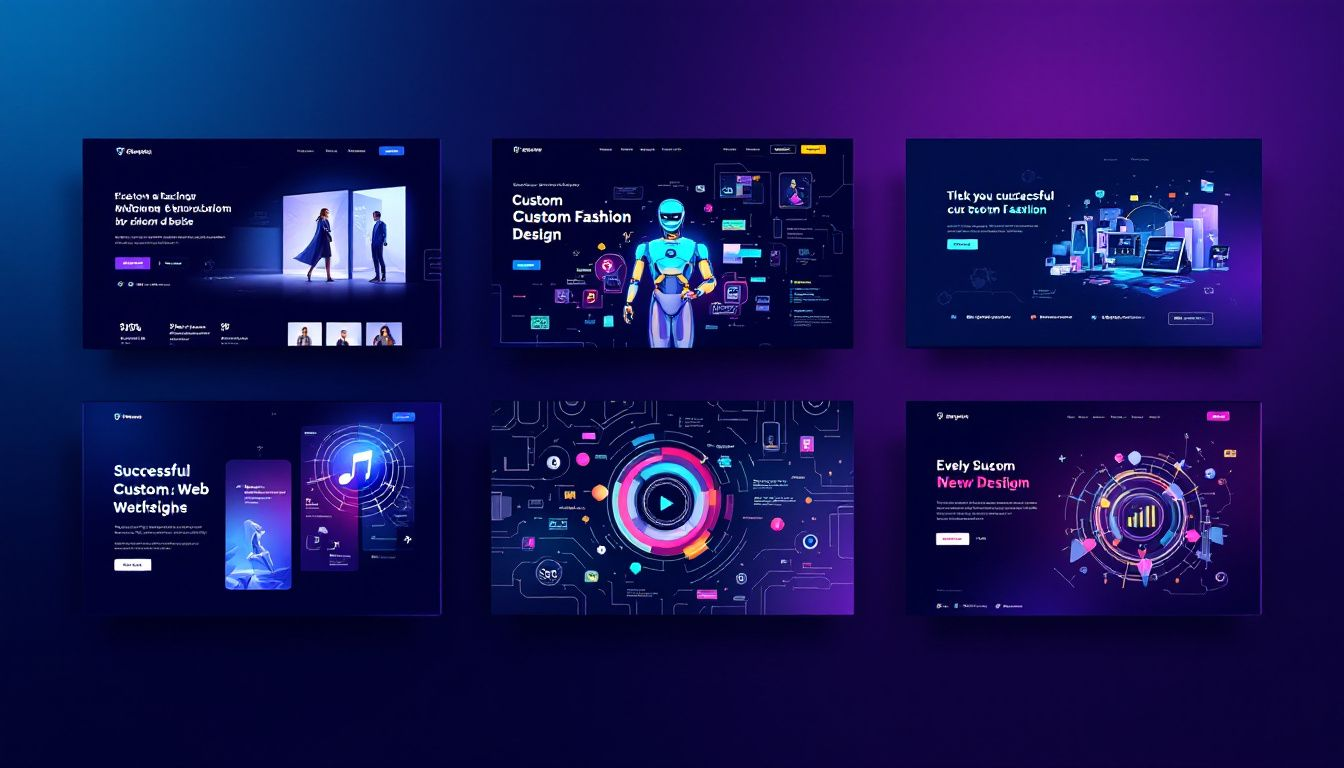Top Tips for Custom Web Design: Create a Unique Website Today

Top Tips for Custom Web Design: Create a Unique Website Today
Key Takeaways
Custom web design offers unparalleled control and scalability, allowing businesses to tailor their websites to their unique needs and grow without complete redesigns.
Effective custom web design involves a structured process including planning, design mockups, development, and thorough testing to ensure user-friendly and visually appealing results.
Maintaining a mobile-friendly, SEO-optimized website is essential for enhancing user experience and brand visibility, supporting better engagement and conversion rates.
Top Tips for Custom Web Design: Create a Unique Website Today

Custom website design offers unparalleled flexibility and control over your site. Unlike pre-made website templates, a custom design allows you to tailor every aspect of your website to your brand’s unique needs and goals. This means you have complete ownership and control over the website and its code, ensuring that it functions exactly how you want it to.
One of the significant advantages of custom web designs is scalability. As your business grows, your website can grow with it without needing a complete redesign. Moreover, you receive continuous support from professional developers, ensuring your site remains up-to-date and functional.
This approach not only sets you apart from competitors but also ensures that your online presence reflects your brand’s unique identity and vision.
Introduction
This blog post provides top tips for creating a custom website that is both visually appealing and user-friendly. A well-designed site can significantly enhance your brand’s visibility and engagement, making it easier to attract and retain customers. It covers everything from initial planning to final launch, providing a comprehensive understanding of the custom web design process.
Creating a custom website goes beyond selecting images and templates. It involves understanding your business, identifying your audience, and using the right tools and strategies to meet your specific needs for your own website builder.
Whether adding new pages, integrating features, or refreshing your current design, this guide offers the coding knowledge and inspiration to create a unique and effective website.
Why Choose Custom Web Design?

Custom website design offers several advantages over templated designs. Here are some key benefits:
It allows you to distinguish your brand from competitors, ensuring a unique online presence.
Unlike website builders that rely on pre-made templates, custom designs provide continuous support from professional developers.
You gain complete ownership and control over your site and its code.
These advantages make custom website design a valuable investment for your online presence.
Scalability is another key benefit of custom web designs. As your business grows, your website can be easily updated and expanded without the need for a complete redesign. Additionally, custom designs improve brand performance by enhancing visibility, engagement, and conversions. They also offer faster loading times, which can significantly enhance the user experience compared to templated designs.
Key Elements of Effective Custom Web Design
Effective custom website design incorporates several critical elements that contribute to a seamless user experience. A clean design featuring ample whitespace helps users concentrate on essential content, making it easier for them to navigate and find what they need. Readability is also crucial, achieved by contrasting text with backgrounds and employing appropriate font choices.
A coherent color palette boosts brand recognition and creates a unified visual identity throughout the site. Clear and intuitive navigation encourages users to explore additional content, increasing engagement and reducing bounce rates. Uniformity in design components, such as consistent use of colors, fonts, and layout, aids in delivering a seamless experience across different site pages.
The Custom Web Design Process
The custom web design process involves several stages, each critical to creating a website that meets your specific needs as a web designer and web designers. This journey begins with planning and strategy, followed by design and mockups, and culminates in web development and testing.
Understanding each stage ensures your custom web design project runs smoothly and efficiently.
Planning and Strategy
The first step in the custom web design process is planning and strategy. Identifying your target audience and their expectations is crucial for setting effective website goals. Tools like audience personas and competitor analysis can significantly aid in this stage, helping you understand what your users need and how you can meet those needs.
Clear goals are vital for a successful web design project. Set specific objectives like increasing user engagement or enhancing brand visibility. With a well-defined strategy, you can ensure that every aspect of your custom website design aligns with your business goals and user expectations.
Design and Mockups
The design and mockup phase is where your ideas start to take shape. Wireframes serve as a visual representation of the website’s layout and content hierarchy, guiding the overall design process. Prototypes are then used to accurately represent how the website will perform, allowing for adjustments before finalizing the design.
Incorporating client feedback during this phase is essential to ensure the project aligns with user needs and brand messaging. Mock-ups of the website design are presented to the client before the launch, providing an opportunity to make any necessary changes and ensure the final product meets expectations.
Development and Testing
The development stage encompasses building the website using various coding languages to create the functional aspects of the site. This involves a collaborative effort between developers and designers to ensure that the final product is both visually appealing and technically sound.
Thorough testing of the website across different devices and browsers is critical to ensure that all features work correctly before launch. Comprehensive testing helps identify and resolve any performance issues or bugs, ensuring a smooth and user-friendly experience for all visitors.
Enhancing User Experience with Custom Web Design

Enhancing user experience is a crucial aspect of custom website design. Conducting user research helps tailor the design to meet the specific needs and preferences of your target audience. Effective navigation allows users to find information quickly, enhancing their overall experience and encouraging them to stay longer on the site.
A straightforward and minimalist design prevents overwhelming users, making it easier for them to navigate and engage with your content. Fast-loading pages significantly enhance user satisfaction and decrease the likelihood of users leaving the site due to slow performance.
Incorporating social proof, like testimonials, helps build user trust and confidence in your offerings.
Mobile-Friendly and Responsive Web Design
Having a mobile-friendly custom website is essential, as over 60% of searches are conducted on mobile devices. With the majority of website traffic originating from mobile devices, ensuring your site is mobile-friendly can significantly enhance user experience and improve SEO rankings.
Responsive web design adjusts to various screen sizes, ensuring optimal display across devices. A single responsive website is more efficient than separate mobile and desktop versions, reducing bounce rates and improving conversion rates through enhanced user experience.
SEO Best Practices for Custom Websites
Custom websites are generally more search engine optimization optimized from the start compared to templated designs. Implementing schema markup helps search engines understand website content better, improving visibility and rankings. Conducting keyword research is essential for shaping an effective SEO strategy, ensuring your content aligns with what users are searching for.
Site speed is crucial as it impacts both user experience and SEO rankings. Creating original and engaging content is fundamental to successful SEO strategies, as it attracts organic traffic and encourages user engagement. Maintaining consistency in keyword usage and updating metadata ensures that your website remains relevant and optimized for search engines.
Showcasing Your Brand's Unique Identity

Custom website design powerfully showcases your brand’s unique identity. Highlighting unique brand values, messaging, and style creates a strong and memorable online presence. Key elements reflecting your brand’s identity include your custom logo, color palette, typography, imagery, and illustrations.
Resources like your logo, brand colors, and fonts help maintain brand consistency across your website. This consistent use of design elements enhances brand recognition and creates a cohesive visual experience for your audience, making a strong first impression within just 50 milliseconds.
Integrating Business Tools and Features
Business tools and features can significantly enhance your custom website’s functionality and user experience. Popular eCommerce platforms like WooCommerce, Shopify, and Adobe Commerce (Magento) offer features such as easy checkout and multiple payment options for your online store, improving the shopping experience for your customers.
Third-party applications enhance website functionality, enabling features like secure payment processing and CRM systems. Scheduling software provides users with a seamless online scheduling experience, which is crucial for businesses offering appointments.
Embedding features through plugins helps non-technical users add functionalities like email marketing tools or shopping carts easily.
Case Studies: Successful Custom Web Designs

Many businesses have successfully used custom web design to enhance their online presence. For instance, BRIA launched their new virtual mental healthcare service with a redesigned website aimed at building a patient base. Similarly, RCBC’s redesign organized extensive resource content for multiple audiences, making it easier for updates.
Other examples include a few examples of Sisu’s website redesign, which improved product discoverability and showcased their wellness blog effectively. Hill & Ponton’s complete redesign facilitated better content management and improved user navigation.
These case studies demonstrate how custom web design can significantly enhance a business’s online presence and functionality.
Maintaining and Updating Your Custom Website
Maintaining and updating your custom website is vital for long-term success. Regular content updates ensure relevancy and freshness, engaging visitors more effectively. Incorporating fresh testimonials and case studies can enhance the credibility and appeal of updated content.
Keep track of internal links and replace any broken ones during content updates. Consistent maintenance improves user experience and prevents larger issues down the line.
Staying proactive with updates ensures your website remains a valuable business asset.
What to Look for in a Custom Web Design Agency
Choosing the right custom web design agency is vital for your project’s success. A full-service agency like Digital Silk can provide a comprehensive range of web design services, ensuring that all aspects of your website are expertly handled. Higher-priced services often guarantee quality designs and better support, making them worthwhile investments.
When evaluating potential agencies, look for a strong portfolio that features the designer’s best work along with context explaining the challenges and impact of each project. Client testimonials highlight key factors like communication standards and industry relevance.
Carefully analyzing client feedback and reviews helps you differentiate between web design companies and find the best fit.
Summary
In summary, custom website design offers numerous benefits, including complete ownership and control, scalability, and continuous support from professional developers. By following a structured process that includes planning, design, development, and testing, you can create a unique and effective website that enhances your brand’s visibility and user engagement.
Investing in a custom web design not only helps distinguish your brand from competitors but also ensures a seamless user experience across all devices. By integrating essential business tools and adhering to SEO best practices, your custom website can drive organic traffic and conversions. Take the next step in your web design journey by partnering with a reputable web design agency and watch your online presence flourish.
Frequently Asked Questions
What are the main benefits of custom website design?
Custom website design provides you with full ownership and control, enabling scalability and professional support. It also significantly enhances brand performance and user engagement while ensuring faster loading times.
How does custom web design improve user experience?
Custom web design significantly enhances user experience by tailoring the site to meet specific user needs, ensuring effective navigation, fast loading times, and a cohesive visual identity. This focused approach not only boosts user satisfaction but also fosters trust through usability testing and social proof.
Why is mobile-friendly design important for my website?
Mobile-friendly design is crucial because it accommodates over 60% of website traffic from mobile devices, enhancing user experience and performance. A responsive design also boosts SEO rankings and decreases bounce rates, ultimately driving more engagement on your site.
What should I look for in a custom web design agency?
When choosing a custom web design agency, prioritize a full-service agency with a strong portfolio and positive client testimonials. Investing in a higher-priced agency often leads to better quality designs and support, ultimately benefiting your business.
How can I ensure my custom website remains relevant and up-to-date?
To ensure your custom website remains relevant and up-to-date, regularly update content, incorporate fresh testimonials and case studies, and maintain internal links. These practices enhance user experience and safeguard against larger issues, making your site more valuable.